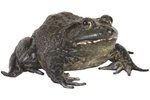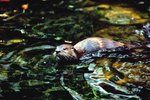
Hiding amid mats of floating vegetation, large anacondas are capable of subduing virtually any animal that ventures into striking range. While the water and plants help the giant snakes to ambush prey, small individuals also derive protection from the dense cover. However, anacondas are adaptive animals, and they use other forms of shelter as well, including rocks, logs, animal burrows and mud.
Anaconda Basics
Four anaconda species inhabit South America: the green (Eunectes murinus), yellow (Eunectes notaeus), dark-spotted (Eunectes deschauenseei) and Bolivian (Eunectes beniensis). All four species are biologically similar, and are thoroughly aquatic constrictors that spend most of their time in sluggish bodies of water, such as swamps and ponds. Anacondas prey on mammals, crocodilians, birds and other anacondas. Female anacondas grow much larger than males—green anaconda females may exceed 20 feet in length and 500 pounds in weight, making them the largest snakes on earth.
In the Water
The water itself provides some shelter for anacondas, and it serves as a buffer against wide temperature fluctuations. Anacondas possess numerous adaptations that help them to excel at their aquatic lifestyle, including dorsally placed eyes and nostrils. This positioning allows them to keep most of their bodies underwater, and breach the surface only with the tips of their heads. Additionally, anacondas can hold their breath for a very long time; if threatened, they can usually simply submerge themselves and wait for terrestrial predators to go away.
Aquatic Plants
The primary hiding spot for anacondas is amid the roots and stems of aquatic plants. One of the world’s leading anaconda researchers, Jesus Rivas, finds most of the anacondas he studies hiding amid mats of vegetation in shallow water. Rivas and his team walk barefoot through dense vegetation at the water’s edge, using their feet to feel for the submerged snakes. Without shoulders and limbs to get caught in the plants, anacondas are better suited to this habitat than many of their prey or predators.
Caves and Burrows
Like most snakes, anacondas are incapable of digging burrows, though they will readily take over the burrows of other animals. Living near the water, anacondas share their territory with a variety of animals that tunnel into riverbanks. Anacondas sometimes eat the inhabitants of these burrows before taking their homes over. Occasionally anacondas will use the small caves and crevices bordering rivers for shelter as well.
Moving through the Mud
Adapted for living near the water, anacondas are susceptible to dehydration during droughts. This is especially true of anacondas living in the seasonally flooded Llanos area of Colombia and Venezuela. When the dry season comes, the anacondas must find areas with standing water to survive. If they cannot find a permanent water source, they burrow into the mud to slow the rate of dehydration. This behavior—termed aestivation—is a summertime parallel to hibernation; the snakes are inactive during a period of inhospitable climate, and emerge only when acceptable conditions—the rains, in this case—return.
References
Photo Credits
-
Tom Brakefield/Stockbyte/Getty Images




